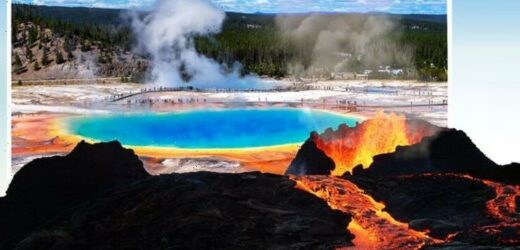Yellowstone volcano’s magma chamber mapped in documentary
We use your sign-up to provide content in ways you’ve consented to and to improve our understanding of you. This may include adverts from us and 3rd parties based on our understanding. You can unsubscribe at any time. More info
Yellowstone is one of a dozen supervolcanoes on Earth, each at least seven times more powerful than Mount Tambora, which produced the biggest recorded eruption in history. Supervolcanoes have a Volcanic Explosivity Index [VEI] of eight, the highest value on the index.
In a monthly update, Mike Poland, the scientist in charge of the Yellowstone Volcano Observatory noted: “The University of Utah Seismographic stations, which is responsible for the operation and maintenance of the Yellowstone seismic network, located 105 earthquakes during the month of January.
“The largest was a magnitude of 2.5, located just south of the Mammoth Hot springs in Yellowstone National Park.
“In fact, this earthquake was part of a sequence of earthquakes, a small swarm of 42 events that occurred between January 5th and January 31st.
“Swarms like these are very common, and in fact, about 50 percent of all earthquakes occur as part of swarms in Yellowstone National Park.


“The rest of the earthquakes during the month were distributed throughout the region.”
In the past 2.1 million years, Yellowstone has erupted three times, the most recent having occurred roughly 640,000 years ago, and was 1,000 times bigger than the devastating Mount St Helens eruption of 1980.
The main feature of a supervolcano is the large magma chamber, an underground reservoir filled with hot, flowing rock.
Yellowstone is said to be due to an eruption based on the cycle of previous eruptions, though it is generally accepted that anything within the next 10,000 years is unlikely.
Some of the most dangerous volcanoes in the world

Dr Poland also added that the researchers recorded an “anomaly” in their reading in December.
He said: “There’s a bit of an anomaly right here in mid-December, and that was caused by heavy snowfall that covered the antenna.
“Once the snow melted, you can see that we’re back to the normal trend.”
Last December, Yellowstone volcano experts at the US Geological Survey (USGS) have warned that the state of Idaho is “extremely” likely to experience multiple earthquakes and eruptions before Yellowstone does.
DON’T MISS:
Putin strikes! Russia cuts gas supply after Biden’s troops make ‘de… [INSIGHT]
Black hole warning as rogue body spotted wandering wandering Milky Way [REVEAL]
Biden makes move as Putin warned he risks losing ‘cash cow’ [SPOTLIGHT]


Seismic activity has risen in central Idaho in the past 20 months, prompting fears of something sinister brewing in the neighbouring Yellowstone National Park.
Professor Michael Rampino, a geologist at New York University, considered how the deadliest part of the supervolcano eruption would be the gases that remain in the air, rather than the ash that falls to the ground.
He visited an old tombstone in New Hampshire that reports the events of 1816, a year that became known as the ‘Year Without a Summer’.
Severe climate abnormalities caused average global temperatures to decrease by 0.4℃ to 0.7℃.
Evidence suggests that this was caused by the 1815 Mount Tambora eruption — the most powerful recorded eruption in history.
Prof Rampino said: “This is a memorial to a farmer named Reuben Whitten who managed to save the town of New Hampshire by growing enough wheat on his land to feed the community.
Source: Read Full Article


